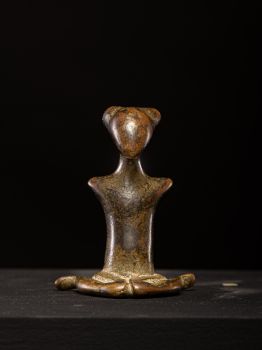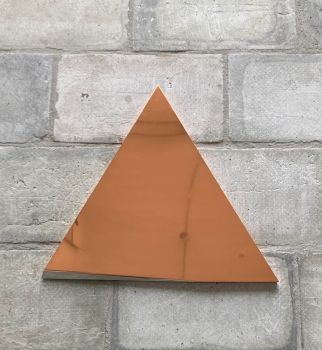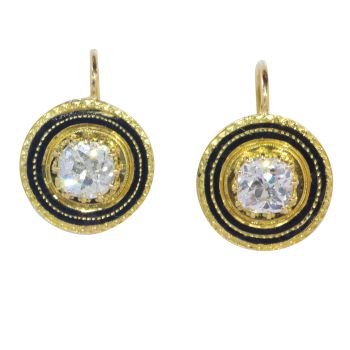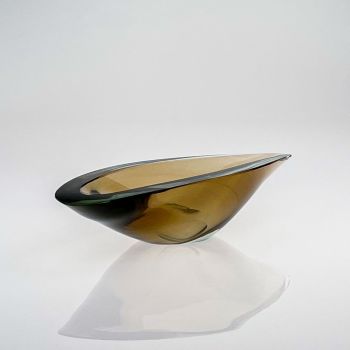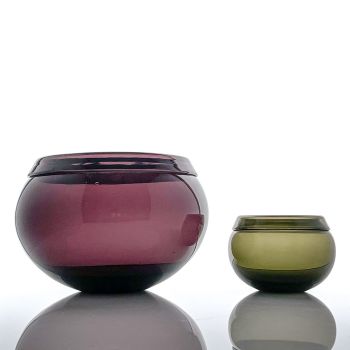A multicoloured enameled copper plate – 1960’s or 1970’s 1960 - 1979
Oppi Untracht
MetalRed copperEnamel
2 cm, ø 17 cm
ConditionVery good
€ 650
Van Kerkhoff Art
- About the artworkA multicoloured enameled copper plate, with spot textured areas. Handmade by Oppi Untracht in his own workshop in the 1960’s or 1970’s. The plate is signed on the reverse by the artist in diamondpen: Oppi.
Oppi Untracht taught enameling at the Brooklyn Museum Art school. The copper plates Oppi Untracht and his wife Saara Hopea used were hand lathe spun by Abram Bender in New York.
About Oppi Untracht
Oppi Untracht (New York City 1922– Porvoo, Finland 2008) was an American master metallurgist, educator, photographer and writer renowned for his significant contributions to the study and documentation of traditional and contemporary crafts, particularly in the fields of jewelry and metalwork. His work stands as a vital bridge connecting Western and Eastern craft traditions, providing in-depth insights into the techniques, cultural contexts, and artistic expressions of various artisans.
Born in New York City in 1922, Untracht developed an early interest in the arts, which led him to pursue formal education in design and craftsmanship at the Columbia University in New York.
Untracht’s career was marked by a profound dedication to exploring and documenting the intricate world of crafts. He traveled extensively, particularly in Scandinavia, where he immersed himself in studying traditional metalwork and jewelry. His passion for understanding different cultural approaches to craft led him to Finland, where he spent several years researching and practicing local techniques.
One of Untracht’s most significant contributions was his ability to synthesize and present complex craft techniques in a way that was accessible and educational for a broad audience. His seminal book, “Metal Techniques for Craftsmen,” published in 1968, became an essential reference for students, artisans, and scholars. The book meticulously detailed various methods of metalworking, providing comprehensive instructions and illustrations that have stood the test of time.
A pivotal period in Untracht’s life was his time in India, where he delved into the rich traditions of Indian jewelry and metalwork. His marriage to Saara Hopea, a renowned Finnish glass and jewelry designer, and his subsequent immersion in Indian culture profoundly influenced his work. Untracht’s deep respect for Indian artisans and their techniques is evident in his acclaimed book, “Traditional Jewelry of India” (1997). This exhaustive study is celebrated for its meticulous research, stunning photography, and insightful analysis of India’s diverse jewelry traditions.
Oppi Untracht’s legacy is characterized by his exceptional ability to document and preserve traditional craft techniques while fostering a greater appreciation for the artistry involved. His work continues to inspire new generations of craftsmen and scholars. Untracht’s books remain authoritative resources, and his photographic archives serve as a valuable visual record of traditional crafts that might otherwise have been forgotten.
Marked
Marked in diamondpen underneath the base: Oppi
Execution
Made in his own workshop: post 1968
Condition
This plate is in good vintage condition. No chips, no dents, some scratches mostly underneath the base.
Literature
Oppi Untracht – Saara Hopea-Untracht: her life and work.
Oppi Untracht – Metal Techniques for Craftsmen
Dimensions
Height 2,3 cm
Diameter 17,3 cm - About the artist
Oppi Untracht, a renowned artist, educator, and author, was born in Brooklyn on November 17, 1922. After earning his degree from New York University in 1946, he pursued further education at Columbia University, where he obtained a master’s degree in art education in 1947. During this time, Untracht studied photography under the iconic Lisette Model and Berenice Abbott, briefly working as a photojournalist before finding his passion in enameling.
Untracht's interest in enameling began in 1947, when he taught himself the craft. His talent and dedication quickly led to a teaching position at the Brooklyn Museum of Art School’s New School of Printing and Enameling, where he taught from 1953 to 1963. During this period, his work garnered attention for its painterly, abstract style, and he exhibited and sold his pieces at New York's America House, a platform for emerging artists and craftspeople.
Untracht was not content with merely following traditional enameling techniques. In his quest to push boundaries, he began experimenting with new methods, which he documented in his influential 1957 book Enameling on Metal. This seminal work not only detailed the conventional techniques but also introduced innovative methods, such as overfiring and incorporating oxidized areas into the design. He embraced new materials that had become available post-World War II, encouraging a fresh approach to enameling that inspired a new generation of artists.
In 1960, Untracht married Saara Hopea, a Finnish designer and silversmith. The couple embarked on a collaborative journey, creating enamels that were sold in galleries across the United States throughout the 1960s. Their works, primarily bowls and plates, showcased their mastery of the medium and became highly sought after. Untracht's works earned him numerous accolades, including a prize at the 1962 New York Annual for his enamels.
The Untrachts were invited in 1962 to join an artistic cooperative in New York, providing them access to large kilns for creating enamel pieces for architectural applications. Though the project was short-lived, they produced several large panels and expanded the scope of their craft.
In 1957, Untracht was awarded a Fulbright fellowship, which allowed him to travel throughout India for two years, documenting the country's traditional and contemporary crafts. His passion for travel and ethnographic research continued in 1963, when he and Saara spent four years in Nepal and India, capturing the diverse crafts of the region. After returning in 1967, the couple relocated to Finland, where Untracht focused on his writing and research.
Over the course of his career, Untracht published several landmark books, including Metal Techniques for Craftsmen (1968), Jewelry Concepts and Technology (1982), Saara Hopea-Untracht: Life and Work (1988), a tribute to his late wife, and Traditional Jewelry of India (1997). These publications became essential resources for artists, scholars, and jewelry enthusiasts alike. Untracht also contributed to numerous other volumes and journal articles, sharing his deep knowledge of traditional crafts with the world.
Throughout his life, Untracht received numerous accolades. In 1998, he was made an honorary fellow of the American Crafts Council and was awarded its Lifetime Achievement Award for his contributions to the field. The following year, he was named an honorary member of the Society of North American Goldsmiths. His expertise and influence spanned continents, yet he spent the later years of his life in the tranquil, historic town of Porvoo, Finland, where he continued to create, research, and write until his passing.
Oppi Untracht’s legacy is one of exploration, innovation, and a deep commitment to preserving and advancing the crafts he so passionately studied and practiced. His contributions to enameling, metalwork, and jewelry design continue to inspire artists and craftspeople worldwide.
Are you interested in buying this artwork?
Artwork details
Related artworks
- 1 - 4 / 6
Onbekende Kunstenaar
Chinese gilt bronze censer, Xuande mark, 18th century, Qing dynasty18th century
Prijs op aanvraagMenken Works of Art
Onbekende Kunstenaar
A white jade ‘Lotus Seedpod and Bug’ carving, Qing dynasty, 18th century18th century
Prijs op aanvraagMenken Works of Art
Onbekende Kunstenaar
Twee centauren, Frans of Italiaanslate 18th
Prijs op aanvraagRobert Schreuder Antiquair
1 - 4 / 24- 1 - 4 / 24
- 1 - 4 / 12

















